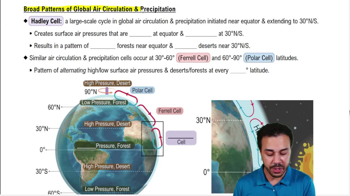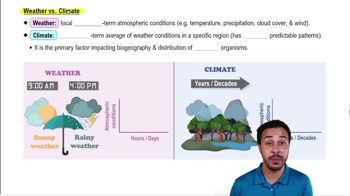Explain why the construction of wildlife corridors can help maintain genetic diversity in a fragmented landscape.
Table of contents
- 1. Introduction to Biology2h 42m
- 2. Chemistry3h 40m
- 3. Water1h 26m
- 4. Biomolecules2h 23m
- 5. Cell Components2h 26m
- 6. The Membrane2h 31m
- 7. Energy and Metabolism2h 0m
- 8. Respiration2h 40m
- 9. Photosynthesis2h 49m
- 10. Cell Signaling59m
- 11. Cell Division2h 47m
- 12. Meiosis2h 0m
- 13. Mendelian Genetics4h 44m
- Introduction to Mendel's Experiments7m
- Genotype vs. Phenotype17m
- Punnett Squares13m
- Mendel's Experiments26m
- Mendel's Laws18m
- Monohybrid Crosses19m
- Test Crosses14m
- Dihybrid Crosses20m
- Punnett Square Probability26m
- Incomplete Dominance vs. Codominance20m
- Epistasis7m
- Non-Mendelian Genetics12m
- Pedigrees6m
- Autosomal Inheritance21m
- Sex-Linked Inheritance43m
- X-Inactivation9m
- 14. DNA Synthesis2h 27m
- 15. Gene Expression3h 20m
- 16. Regulation of Expression3h 31m
- Introduction to Regulation of Gene Expression13m
- Prokaryotic Gene Regulation via Operons27m
- The Lac Operon21m
- Glucose's Impact on Lac Operon25m
- The Trp Operon20m
- Review of the Lac Operon & Trp Operon11m
- Introduction to Eukaryotic Gene Regulation9m
- Eukaryotic Chromatin Modifications16m
- Eukaryotic Transcriptional Control22m
- Eukaryotic Post-Transcriptional Regulation28m
- Eukaryotic Post-Translational Regulation13m
- 17. Viruses37m
- 18. Biotechnology2h 58m
- 19. Genomics17m
- 20. Development1h 5m
- 21. Evolution3h 1m
- 22. Evolution of Populations3h 53m
- 23. Speciation1h 37m
- 24. History of Life on Earth2h 6m
- 25. Phylogeny2h 31m
- 26. Prokaryotes4h 59m
- 27. Protists1h 12m
- 28. Plants1h 22m
- 29. Fungi36m
- 30. Overview of Animals34m
- 31. Invertebrates1h 2m
- 32. Vertebrates50m
- 33. Plant Anatomy1h 3m
- 34. Vascular Plant Transport1h 2m
- 35. Soil37m
- 36. Plant Reproduction47m
- 37. Plant Sensation and Response1h 9m
- 38. Animal Form and Function1h 19m
- 39. Digestive System1h 10m
- 40. Circulatory System1h 49m
- 41. Immune System1h 12m
- 42. Osmoregulation and Excretion50m
- 43. Endocrine System1h 4m
- 44. Animal Reproduction1h 2m
- 45. Nervous System1h 55m
- 46. Sensory Systems46m
- 47. Muscle Systems23m
- 48. Ecology3h 11m
- Introduction to Ecology20m
- Biogeography14m
- Earth's Climate Patterns50m
- Introduction to Terrestrial Biomes10m
- Terrestrial Biomes: Near Equator13m
- Terrestrial Biomes: Temperate Regions10m
- Terrestrial Biomes: Northern Regions15m
- Introduction to Aquatic Biomes27m
- Freshwater Aquatic Biomes14m
- Marine Aquatic Biomes13m
- 49. Animal Behavior28m
- 50. Population Ecology3h 41m
- Introduction to Population Ecology28m
- Population Sampling Methods23m
- Life History12m
- Population Demography17m
- Factors Limiting Population Growth14m
- Introduction to Population Growth Models22m
- Linear Population Growth6m
- Exponential Population Growth29m
- Logistic Population Growth32m
- r/K Selection10m
- The Human Population22m
- 51. Community Ecology2h 46m
- Introduction to Community Ecology2m
- Introduction to Community Interactions9m
- Community Interactions: Competition (-/-)38m
- Community Interactions: Exploitation (+/-)23m
- Community Interactions: Mutualism (+/+) & Commensalism (+/0)9m
- Community Structure35m
- Community Dynamics26m
- Geographic Impact on Communities21m
- 52. Ecosystems2h 36m
- 53. Conservation Biology24m
53. Conservation Biology
Conservation Biology
Problem 9
Textbook Question
Suppose that record snows blanket your campus this winter. Your friend says this is proof that global warming isn't really occurring. What is the flaw in your friend's logic?
a. The average temperature of the Earth is not actually increasing.
b. Global warming refers to temperatures, but snow is a type of precipitation.
c. While the average global temperature is increasing, local temperatures and precipitation (weather) will vary.
d. Your friend is confusing global warming and global climate change.
 Verified step by step guidance
Verified step by step guidance1
Understand the difference between weather and climate: Weather refers to short-term atmospheric conditions in a specific place at a specific time, while climate refers to long-term patterns and averages of weather over a larger region and longer time period.
Recognize that global warming is a component of global climate change, which refers to long-term changes in temperature, precipitation, and other atmospheric conditions on Earth.
Acknowledge that global warming refers to the increase in Earth's average surface temperature due to rising levels of greenhouse gases.
Consider that local weather events, such as record snowfall, do not disprove global warming. Local weather can vary significantly and is influenced by many factors, including natural variability.
Conclude that while the average global temperature is increasing, this does not mean that every location will experience warmer temperatures at all times. Local weather patterns can still result in cold weather events, even in a warming world.
 Verified video answer for a similar problem:
Verified video answer for a similar problem:This video solution was recommended by our tutors as helpful for the problem above
Video duration:
2mPlay a video:
Was this helpful?
Key Concepts
Here are the essential concepts you must grasp in order to answer the question correctly.
Global Warming
Global warming refers to the long-term increase in Earth's average surface temperature due to human activities, primarily the emission of greenhouse gases. It is a global phenomenon affecting climate patterns over decades, not just isolated weather events. Understanding global warming requires distinguishing between short-term weather fluctuations and long-term climate trends.
Recommended video:
Guided course

Broad Patterns of Global Air Circulation & Precipitation
Weather vs. Climate
Weather describes short-term atmospheric conditions in a specific area, including temperature, precipitation, and wind. Climate, on the other hand, refers to the long-term average of weather patterns over a significant period, typically decades. Recognizing the difference between weather and climate is crucial for understanding how local weather events do not necessarily reflect broader climate changes.
Recommended video:
Guided course

Weather vs. Climate
Global Climate Change
Global climate change encompasses changes in global weather patterns, including temperature, precipitation, and storm frequency, driven by factors like global warming. It involves both warming and cooling trends, as well as shifts in precipitation patterns. Understanding climate change requires considering how global warming influences diverse aspects of Earth's climate system beyond just temperature increases.
Recommended video:
Guided course

Pollution and Climate Change

 3:56m
3:56mWatch next
Master Conservation Biology and Biodiversity with a bite sized video explanation from Jason
Start learningRelated Videos
Related Practice
Textbook Question
836
views
